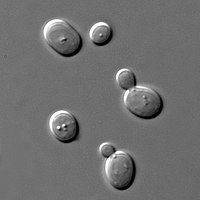
Photo from wikipedia
Bubble-induced transport is a ubiquitous natural and industrial phenomenon. In brewery, such transport occurs due to gas bubbles generated through anaerobic fermentation by yeasts. Two major kinds of fermentation viz.… Click to show full abstract
Bubble-induced transport is a ubiquitous natural and industrial phenomenon. In brewery, such transport occurs due to gas bubbles generated through anaerobic fermentation by yeasts. Two major kinds of fermentation viz. top (ale) and bottom (lager) fermentation, display a difference in their yeast distributions inside a sugar broth. The reason for this difference is believed to be yeast–bubble adhesion arising due to surface hydrophobicity of the yeast cell wall; however, the physical mechanism is still largely a mystery. In this report, through in vivo experiments, we develop a novel theoretical model for yeast distribution based on the general conservation law. This work clarifies that bubble-induced diffusion is the dominant transport mechanism in bottom-fermentation by lagers whereas, yeast–bubble adhesion plays a leading role in transporting ales in top-fermentation, thereby corroborating the centuries-old belief regarding distribution difference in yeast population in two kinds of fermentation.
Journal Title: Journal of the Royal Society Interface
Year Published: 2020
Link to full text (if available)
Share on Social Media: Sign Up to like & get
recommendations!